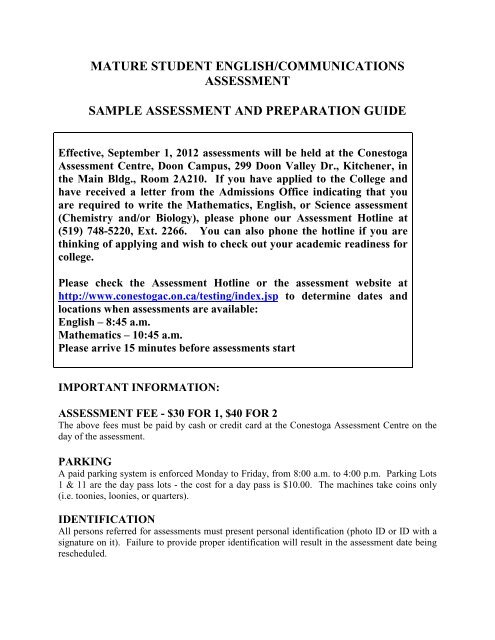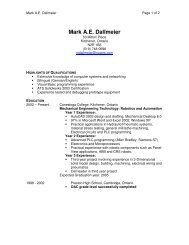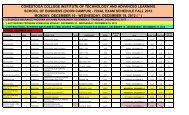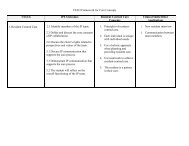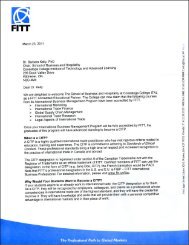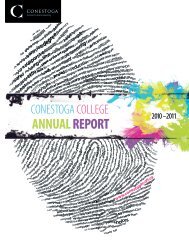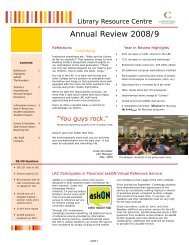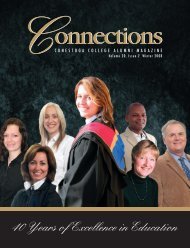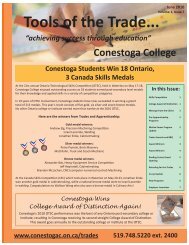Mature student english/communications assessment sample
Mature student english/communications assessment sample
Mature student english/communications assessment sample
Create successful ePaper yourself
Turn your PDF publications into a flip-book with our unique Google optimized e-Paper software.
MATURE STUDENT ENGLISH/COMMUNICATIONS<br />
ASSESSMENT<br />
SAMPLE ASSESSMENT AND PREPARATION GUIDE<br />
Effective, September 1, 2012 <strong>assessment</strong>s will be held at the Conestoga<br />
Assessment Centre, Doon Campus, 299 Doon Valley Dr., Kitchener, in<br />
the Main Bldg., Room 2A210. If you have applied to the College and<br />
have received a letter from the Admissions Office indicating that you<br />
are required to write the Mathematics, English, or Science <strong>assessment</strong><br />
(Chemistry and/or Biology), please phone our Assessment Hotline at<br />
(519) 748-5220, Ext. 2266. You can also phone the hotline if you are<br />
thinking of applying and wish to check out your academic readiness for<br />
college.<br />
Please check the Assessment Hotline or the <strong>assessment</strong> website at<br />
http://www.conestogac.on.ca/testing/index.jsp to determine dates and<br />
locations when <strong>assessment</strong>s are available:<br />
English – 8:45 a.m.<br />
Mathematics – 10:45 a.m.<br />
Please arrive 15 minutes before <strong>assessment</strong>s start<br />
IMPORTANT INFORMATION:<br />
ASSESSMENT FEE - $30 FOR 1, $40 FOR 2<br />
The above fees must be paid by cash or credit card at the Conestoga Assessment Centre on the<br />
day of the <strong>assessment</strong>.<br />
PARKING<br />
A paid parking system is enforced Monday to Friday, from 8:00 a.m. to 4:00 p.m. Parking Lots<br />
1 & 11 are the day pass lots - the cost for a day pass is $10.00. The machines take coins only<br />
(i.e. toonies, loonies, or quarters).<br />
IDENTIFICATION<br />
All persons referred for <strong>assessment</strong>s must present personal identification (photo ID or ID with a<br />
signature on it). Failure to provide proper identification will result in the <strong>assessment</strong> date being<br />
rescheduled.
HOW TO GET TO THE CONESTOGA ASSESSMENT CENTRE<br />
Enter Door #1 of the Main Building (A Wing) and turn right. Room 2A210 is on the right.
PREPARATION AND REVIEW BOOKLET<br />
This booklet is designed to help you prepare for your English, Mathematics and/or Science Skills<br />
Assessment.<br />
HELPFUL HINTS<br />
1. Get a good night’s sleep before the test and arrive early for the testing session.<br />
2. Don’t let the thought of taking a test make you too nervous. Rest assured a little<br />
nervousness is natural and even helpful.<br />
3. Be on time! This will give you the opportunity to familiarize yourself with the test room<br />
and calm the butterflies!<br />
4. Listen carefully and follow directions.<br />
5. Ask questions if anything is unclear. The test administrator is there for that purpose.<br />
6. The tests are multiple choice. You will be required to choose the best answer to a<br />
question from several choices. You may mark an answer even if you are not perfectly<br />
sure it is right.<br />
7. If one question is too hard, leave it and go on to the next. You can always come back and<br />
try it again if there is time.<br />
8. If you come to a section in the test that you cannot do, don’t give up. There may be parts<br />
of the test which are easier for you. Keep working.<br />
9. Work steadily, and complete as many questions as you can.<br />
If you are an applicant with special needs (eg. Physically disabled, blind or visually impaired,<br />
deaf or hard of hearing) and require some form of test accommodation, please contact the<br />
DISABILITY SERVICES OFFICE at (519) 748-5220, Ext. 3232. This office is located at our<br />
Doon Campus.
OVERVIEW<br />
ENGLISH/COMMUNICATIONS ASSESSMENT<br />
The Canadian Adult Achievement Test (CAAT) is a measure of your current functional level in<br />
Reading Comprehension and Language. This battery of achievement tests has been designed<br />
specifically for the Canadian adult, regardless of his or her previous school experience.<br />
THE PURPOSE OF THE CAAT TEST<br />
Conestoga College uses the CAAT test as a pre-admission instrument to assess an applicant’s<br />
readiness for College programs. Please note that the College does not issue a Statement of<br />
Equivalency as part of the test results.<br />
WHAT TO EXPECT<br />
You will be asked to complete two sub-tests:<br />
Introduction and Instructions 15 minutes<br />
1) Reading Comprehension 40 minutes<br />
2) Language 30 minutes<br />
Instructions for the test begin at 8:45 a.m., and you will be finished by 10:15 a.m. All materials<br />
are supplied by the College. We do not allow the use of learning aids, such as dictionaries<br />
and calculators.<br />
THE READING COMPREHENSION TEST<br />
The final goal of reading instruction is comprehension of written material. The Reading<br />
Comprehension sub-test assesses reading comprehension with three types of reading material.<br />
Textual content is similar to that found in non-fiction and general information materials.<br />
Recreational content includes material read for enjoyment, including fiction, humour, literary<br />
criticism, and poetry. Functional content is the type of material encountered in everyday life, eg.<br />
directions, forms, advertising, and labels. Test items are constructed to measure literal,<br />
inferential, and critical levels of comprehension.
SAMPLES:<br />
TALL TALES<br />
Light from the candles bounced off the dark windows and made strange shadows on the walls.<br />
After hearing Uncle Sal’s stories, we all sat nervously, listening for creaking footsteps and<br />
squeaking doors. Leo was the first to speak.<br />
“You don’t really believe all those stories about the old Potter place, do you, Uncle Sal?”<br />
“I don’t know,” Uncle Sal said slowly, “no one has seen Mr. Potter in town for the last five<br />
years. Some say he hasn’t set foot out of the house.”<br />
A. What time of day is it in the story?<br />
a) Morning c) Afternoon<br />
b) Noon d) Evening<br />
B. What kind of stories did Uncle Sal tell?<br />
a) Peaceful c) Sad<br />
b) Scary d) Funny<br />
SAVE ENERGY, SAVE MONEY, SAVE THE ENVIRONMENT<br />
How energy is used in Ontario homes * For an annual energy bill of $2,000<br />
Space heating 57-62% $1,140 - $1,240<br />
Water heating 20-21% $400 - $420<br />
Appliances 12-13% $240 - $260<br />
Lighting 4-5% $80 - $100<br />
Cooling 0-7% $0 - $200<br />
*Many factors can affect your annual energy bill, such as size and location of your home,<br />
yearly variations in weather, efficiency of your furnace and other appliances, thermostat<br />
settings, number of occupants, and the local cost of energy.<br />
C. If an annual energy bill was $1,500, approximately how much of it was for heating<br />
water?<br />
a) $500 c) $300<br />
b) $100 d) $200<br />
D. Presently your annual electric bill is $2,000. If you install an air conditioner, approx.<br />
how much more could your annual electric bill be?<br />
a) $150 - $200 c) $350 - $400<br />
b) $250 - $300 d) $450 - $500<br />
E. What factor would be least likely to affect your annual electric bill?
a) Square footage of house c) Age of furnace and appliances<br />
b) Seasonal changes d) The North American costs of energy<br />
NEED A NEW BLUE BOX?<br />
The Region gives out free Blue Boxes from the locations listed below. If your box is<br />
broken, bring it with you to have it recycled.<br />
Kitchener: Utilities Operation Centre (Stockroom), 83 Elmsdale Drive,<br />
(519) 741-2536; Mon. – Fri., 8:30 a.m. – 4:00 p.m.<br />
Waterloo: Works Yard, 265 Lexington Ct., (519) 886-2634; Mon. - Fri., 8:30 –<br />
4:30<br />
Waste Management Admin. Bldg., 925 Erb St. W., (519) 883-5100,<br />
Mon. – Fri., 8:30 a.m. – 4:30 p.m.<br />
Cambridge: Works Yard, 1310 Bishop St., (519) 621-0740<br />
Mon. – Fri., 7:00 a.m. – 3:30 p.m.<br />
Townships: North Dumfries Twp. Office at R.R. #75 & Greenfield Rd.,<br />
(519) 621-0340; Mon. – Fri., 8:30 a.m. – 4:30 p.m.<br />
Wellesley Twp. Office, ¼-mile east of Crosshill on RR #15,<br />
(519) 699-4611; Mon. – Fri., 8:30 a.m. – 4:30 p.m.<br />
Wilmot Twp. Office, 60 Snyder’s Rd., Baden, (519) 634-8444;<br />
Mon. – Fri., 8:30 a.m. – 4:30 p.m.<br />
Blue Boxes are also available at Small Vehicle Transfer Stations in Cambridge,<br />
Waterloo, Wilmot, Wellesley, North Dumfries and Woolwich Townships. Call (519)<br />
883-5100 for hours.<br />
F. If your blue box has been run over by the garbage truck, to receive a new one you<br />
should:<br />
a) Collect the pieces and take them to the nearest Operation Centre/Works Yard<br />
b) Go to the nearest Operation Centre/Works Yard to order a new blue box<br />
c) Phone (519) 883-5100 to request that a new one be sent to you<br />
d) Take your damaged box to any of the Operation Centres/Works Yards on the<br />
weekend to pick up a new one.<br />
G. You work from 8:00 a.m. – 5:00 p.m. every Monday – Friday. Where is the only<br />
location you can pick up a new blue box?<br />
a) Kitchener c) Cambridge<br />
b) Waterloo d) North Dumfries Township<br />
c)
What's Important by Lynne Kattenhorn<br />
What's Important?<br />
A man of wisdom, long ago, asserted,<br />
"The four things man needs most in life,<br />
Are Health, Love, Beauty and Wealth."<br />
He specified the order, his message to come through.<br />
Thank you Plato for your words, and your wisdom, true.<br />
I can agree with Health and Love, and Beauty sounds right too.<br />
Of Wealth, I'm not quite certain.<br />
You know it's often said, “’tis the root of all that's evil.”<br />
And many hearts have bled, over money and the damage,<br />
To which it's cruel pursuit has led.<br />
All right, I will concede,<br />
Some wealth we may require, to care for physical need.<br />
What's More Important?<br />
It's got to be the lessons.<br />
The knowledge we have gained.<br />
Doesn't come without a struggle, frustration, fear and pain.<br />
It has to be the lessons. Of this I am quite sure.<br />
We've got to do the preparation, improve our attitude.<br />
Yes, it is the lessons, that help us to achieve,<br />
Everything we're meant to, everything we need.<br />
What's Most Important?<br />
To have a soul that's free.<br />
Attain a greater level,<br />
Of Spirituality.<br />
Love, Health, Beauty, Wealth.<br />
Inside is where they're found.<br />
Every wonder, mystery and reason,<br />
We cannot hope to understand.<br />
But of one thing, I am certain,<br />
We each must heed our Call.<br />
And in the Higher Order of Life<br />
There is a place for all.<br />
H. According to the poet, which of the following is most important:<br />
a) Wealth c) Health<br />
b) Love d) Knowledge<br />
I. “Tis the root of all that’s evil” refers to<br />
a) Fear c) Wealth<br />
b) Pain d) Bleeding hearts
THE LANGUAGE SUBTEST<br />
The Language sub-test reflects the current emphasis in language instruction on the development<br />
of sound written communication skills that form the groundwork for writing fluency. It assesses<br />
your reference skills, language sensitivity, conventions and paragraph arrangement.<br />
SAMPLES:<br />
A. Where would be the best place to find out how to pronounce the word “recipe?”<br />
a) An atlas<br />
b) An almanac<br />
c) An encyclopedia<br />
d) A dictionary<br />
B. Which pair of guide words would be found on the same dictionary page as dissident?<br />
a) disguise - dismiss<br />
b) disqualification - distinctive<br />
c) disassociate - discount<br />
d) deserve - detachment<br />
Use the dictionary entries and Pronunciation Guide below to answer the following<br />
questions..<br />
Re-al-ize [ ‘riə,laiz/ v.] 1. To understand, start to believe something is true; 2. To gain, make<br />
money; 3. To make something become true<br />
C. Which definition best fits the word realize as it is used in this sentence:<br />
The woman will realize a profit from the sale of her house.<br />
a) Definition 1<br />
b) Definition 2<br />
c) Definition 3<br />
D. The vowel sound in the final syllable of realize has the same sound as the i in:<br />
a) scissors<br />
b) tizzy<br />
c) abide<br />
E. There are four sentences that express the same idea. Decide which sentence expresses<br />
the idea best.<br />
a) Ed went at the mall to the shoe store.<br />
b) Ed’s shoe store at the mall.<br />
c) Ed went to the shoe store at the mall.<br />
d) To the shoe store at the mall went Ed.
In the paragraph below, certain parts have been underlined and labeled. These labels correspond<br />
to the letter of the question. Please indicate if it is an error in grammar, punctuation,<br />
capitalization or if there is no error: There is never more than one type of error in any underlined<br />
part.<br />
Understanding learning styles<br />
F.<br />
An adult learner can greatly improve their performance by understanding and building on the<br />
G.<br />
strengths of his preferred learning style. A persons’ preferred learning style can greatly assist<br />
H.<br />
in unlocking the mystery of memory. Although, it is possible for someone to have more than<br />
I.<br />
one learning style one style usually presents stronger than the others. The three basic learning<br />
J.<br />
styles include the following: Visual, auditory, and kinesthetic.<br />
K.<br />
F. a) Grammar error<br />
b) Punctuation error<br />
c) Capitalization error<br />
d) No error<br />
G. a) Grammar error<br />
b) Punctuation error<br />
c) Capitalization error<br />
d) No error<br />
H. a) Grammar error<br />
b) Punctuation error<br />
c) Capitalization error<br />
d) No error<br />
I. a) Grammar error<br />
b) Punctuation error<br />
c) Capitalization error<br />
d) No error<br />
J.. a) Grammar error<br />
b) Punctuation error<br />
c) Capitalization error<br />
d) No error
K.. a) Grammar error<br />
b) Punctuation error<br />
c) Capitalization error<br />
d) No error<br />
Read the group of four sentences below. Then decide how to arrange each group of sentences<br />
into a well-organized paragraph by putting the sentences in order from first to last.<br />
1. She phoned CAA for roadside assistance.<br />
2. Carolyn was driving to the mall to do some shopping.<br />
3. Three hours later, the tow truck finally appeared to take her car to the garage.<br />
4. Suddenly her car started to sputter and then stopped.<br />
L. In the paragraph, which sentence should be first?<br />
a) sentence 1<br />
b) sentence 2<br />
c) sentence 3<br />
d) sentence 4<br />
M. In the paragraph, which sentence should be second?<br />
a) sentence 1<br />
b) sentence 2<br />
c) sentence 3<br />
d) sentence 4<br />
N. In the paragraph, which sentence should be third?<br />
a) sentence 1<br />
b) sentence 2<br />
c) sentence 3<br />
d) sentence 4<br />
O. In the paragraph, which sentence should be fourth?<br />
a) sentence 1<br />
b) sentence 2<br />
c) sentence 3<br />
d) sentence 4
ANSWERS<br />
Reading Comprehension Language<br />
A. (d) A. (d) K. (c)<br />
B. (b) B. (b) L. (b)<br />
C. (c) C. (b) M. (d)<br />
D. (a) D. (c) N. (a)<br />
E. (d) E. (c) O. (c)<br />
F. (a) F. (c)<br />
G. (c) G. (a)<br />
H. (d) H. (b)<br />
I. (c) I. (b)<br />
J. (b)


